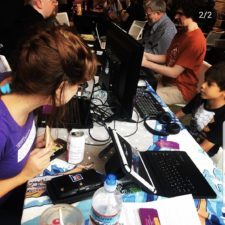About a week has gone by since I published “Foot in the Door.” I intended to write a new post last week but there was so much marketing to do that I felt overwhelmed. This online oversaturated world we live in has forced us all to become marketers. We must shout from the digital rooftops in order to be heard above the din. That is usually a necessity for marketing your product, unfortunately.

Selling things has never been my strong suit, in fact I would say it is one of my biggest weaknesses. The only way I have gotten better at it is through slow and painstaking practice. Though I have had a Twitter account for years, I find it difficult to post every day and come up with witty retorts. My biggest successes in the past have always been when I took advantage of a young service or platform and been one of the early adopters.
When the Amazon KDP service was still young and most people thought self-publishing was a terrible idea, I uploaded a few of my short stories for free on the platform. Because there were so few items like that available at the time I received a tremendous number of downloads.

With this book I knew that wasn’t going to be an option. I wanted to work on building a list of subscribers for a newsletter. One where I could share the interesting creative coding content I come across every week. My research indicated that solo-preneurs benefit greatly from having their own email newsletter. Sadly, I had been putting it off for a while.
I also noticed providing free content in a landing page/email subscription being a common strategy across the web. I wanted this book to be accessible to anyone who wanted to learn to code. However, I felt that it would be counterintuitive and unproductive to charge people. Especially because the book is still quite short. I also knew from my past experience that my distribution would be reduced if I charged people for the book.
Though my main lane of distribution would be through my newsletter landing page, I decided a week after launch that it wouldn’t hurt to make a paperback version of my book available through the Amazon store. After all, I could order author copies and organize giveaways. Not to mention, Amazon had far wider reach than me. Might also grow my audience.
Being involved with the Women Make community of creative women in (primarily) tech was immensely helpful. The community helped to support each other during the month long “Just F*cking Ship It” Challenge. It also helped that I had already written a portion of the book a year prior, but lacked the motivation to finish it. Since my marketing skills are less than stellar, having my book included in the final product page when the challenge was over also acted like extra free promotion.

Another way I shared my book was on Facebook groups. I found relevant groups related to creative coding, software engineers, learning to code, and women in tech. I wrote a paragraph about the book and shared the link. Then I made sure to tweak that paragraph of text. If it was a group for self-taught programmers, I made sure to mention I was self taught.
There are also several blogging platforms I re-post to, including Dev.to, Medium, and (more recently) Gamasutra. On Medium there are publications like “Code Like a Girl” that I submit to in order to extend my reach. These can be a toss up in terms of how much of the audience ever clicks the link back to my blog and discovers my free book.
Finally I made my first Product Hunt page, which was probably the most nerve wracking part of my marketing process. I love to browse Product Hunt and see all the curious, strange, wacky, and actually really useful and interesting applications makers launch on the platform.

I did not end up getting featured on Product Hunt that day. But, I did get more upvotes than I was expecting and even a few followers. Also, Product Hunt gets a lot more visitors per day than my blog. So it’s still a great way to bring more subscribers and have another permanent backlink to book. There is also a search feature on Product Hunt. That means if people are searching for books about learning to code or breaking into the tech industry, they might very well come across mine.
So now for some stats! I believe in sharing data with other makers because that is how we all grow. So far I have 284 subscribers, a number I’m pretty happy with. That’s just 2 weeks after the release of my book. Of those 284, 54% have actually opened and clicked to download my book. I’m less happy with that number. However, I imagine because of filters and robots thats closer to the number of real people wanting to read my book.

I’m hoping to raise that number to 500 within the next month. Going to keep posting on social media regularly. Although Facebook gets the most clickbacks, I also share on LinkedIn, Twitter, and even Pinterest. I think so far I underestimated LinkedIn the most. I am happy I decided to give that platform a try.
Hopefully this data will help you as you work on marketing your own product. As makers I believe we should support each other. If you have something interesting to share that you are working on, you should post it in the comments! I look forward to hearing about it. If you want to keep up with what I’m doing, you can follow me on Twitter now @nadyaprimak. If you’re interested in learning more about my book, you can check out an excerpt here.






















